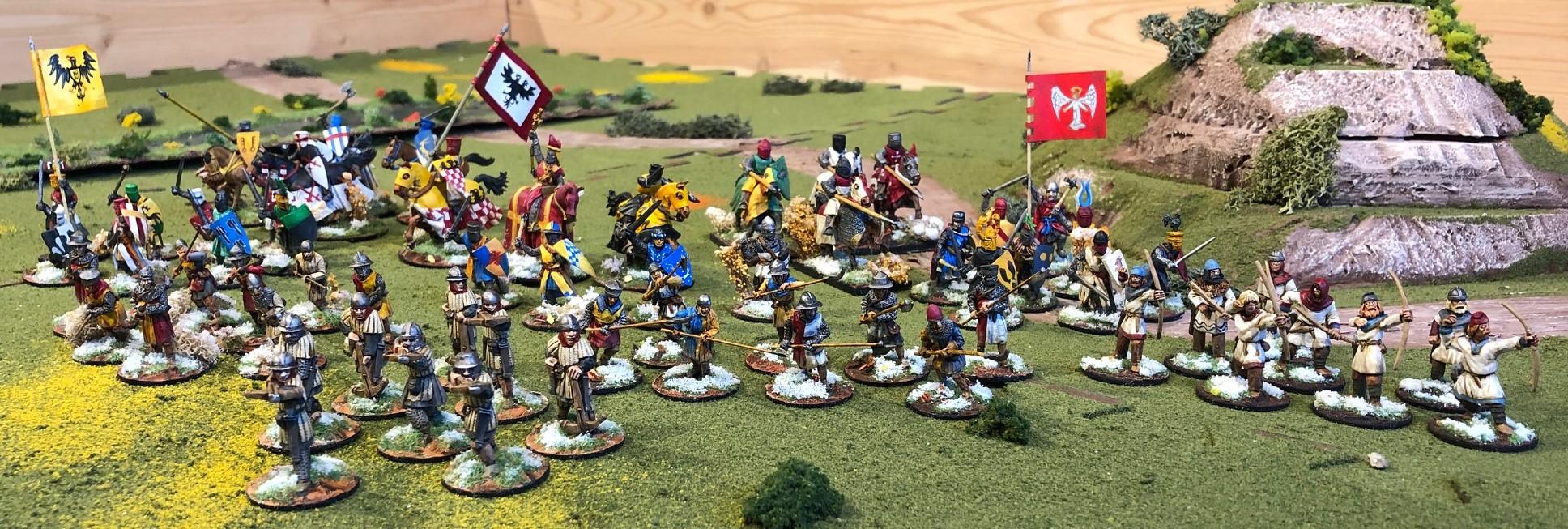I posted up a brief fig comparison previously, but have since finished up a decent chunk of the figures in my lead pile.
I’ve been interested in the crusades for over 20+ years now and more recently (within the last 3-4 years) expanded out a little beyond the well known ones in the middle east and been reading a little about some of the less popularized ones that happened in Europe itself (such as the Albigensian or Baltic Crusades). The Baltic Crusades, in particular, are very interesting as the situation was not wholly dissimilar to the Middle East. You had small Christian territories, surrounded by ‘pagan’ peoples with a nearby semi hostile Christian power in the Orthodox Church. However, unlike Outremer, these were essentially successful. From Prussia through to Estonia lands were effectively conquered and converted. The military orders, too, were more successful (the Teutonic Knights for 200 years were largely successful until 1410’s debacle, but even then, they could be seen as successful as the opponents were all converted by this time).
Fall of 2019 saw a perfect chance to pick up some figs to model this interesting, politically complex, and dynamic landscape in the form of the Baron’s War Kickstarter. I picked up a bevy of foot knights and troopers to add to various plastic and metal kits and got to painting work in February. Thanks to the virus causing widespread lockdown, I’ve managed a relatively decent clip building, converting, and painting a sizable force of models.
I chose earlier in the time period, circa 1220-1300ish as the arms and armor is more appealing, and the frontier was less defined. As most of the warfare took place in late fall to early spring, I’ve elected to base the figs with a feeling of early snows in autumn enabling a raid prior to full snow pack. To assist with ideas for painting I picked up the Codex Manesse and a copy of the Zurich Wappenrolle to look up arms for various German and Swiss towns or individuals. This added a lot of character and gave me a good excuse to convert some figs to capture the German penchant for flashy head gear on some of the figures.
First up some of the mounted cavalry:
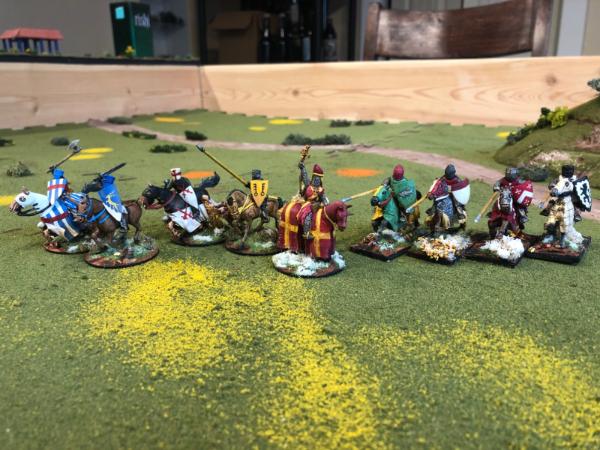 Left to Right: Fireforge, Conquest, Fireforge, Conquest, Baron’s War, Gripping Beast x4
Left to Right: Fireforge, Conquest, Fireforge, Conquest, Baron’s War, Gripping Beast x4The Conquest figs and the Fireforge are, in my opinion, the way to go for cavalry. Baron’s War figs are ludicrously expensive in this area, and the two plastic sets offers so much more in terms of variation. Gripping Beast is really showing its age as a range, the sculpts are chunky and generally have a lot of flash/miscast issues.
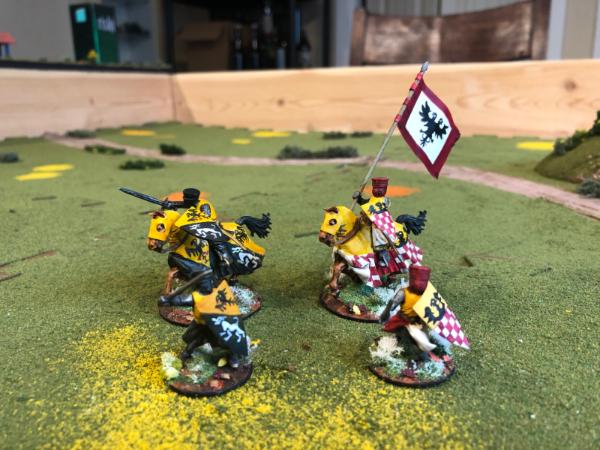 Left to Right: Fireforge, Fireforge
Left to Right: Fireforge, FireforgeHere I did an overall commander and a banner bearer, with corresponding foot models to be used in games where their mounts can be ‘killed’. This also marked a first for me in using thin brass sheets to make my flags. I found it very fiddly when trying to mate the strips that went around the haft of the pole. It made for some nice, sturdy flags, but was a real pain to work with.
It wouldn’t be a crusade force without a bevy of foot knights, plus they look so good when painted up. It is perhaps less well known that the crusaders learned to use foot knights to bolster the ranks of their infantry. In the first crusade many knights lost their horses and fought on foot and this would be adopted as a normal form of war in the middle east. In Northern Europe, the heavy snows, woods, and difficult terrain would have suited this as well, and I’ve included such models in my force.
 Left to Right: Baron’s War, Baron’s War (modified with Victrix bits), Baron’s War, Baron’s War (modified with a green stuff cloak and modified Crusader helmet), Crusader (modified), Crusader (modified with Fireforge hammer and helmet), Baron’s War, Baron’s War
Left to Right: Baron’s War, Baron’s War (modified with Victrix bits), Baron’s War, Baron’s War (modified with a green stuff cloak and modified Crusader helmet), Crusader (modified), Crusader (modified with Fireforge hammer and helmet), Baron’s War, Baron’s War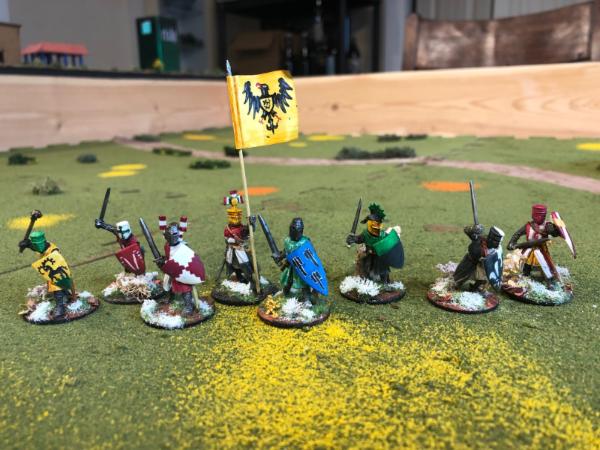 Left to Right: Baron’s War, Baron’s War, Crusader (modified), Baron’s War (modified), Crusader, Crusader (modified), Baron’s War, Baron’s War
Left to Right: Baron’s War, Baron’s War, Crusader (modified), Baron’s War (modified), Crusader, Crusader (modified), Baron’s War, Baron’s WarOverall, I’m extremely happy with how they turned out. The helmet modifications give the group a nice Germanic feel, and every knight utilizes a known coat of arms. It’s a lot of fun (to quote Lawrence of Arabia, “It is recognized that you have a funny sense of fun.”) to do a little research and come up with some heraldry that you can translate. I did this with my Norman milites and foot, and enjoyed extrapolating simplified versions for an earlier period, while this was perfect for delving into items that would give the force diversity of color while still maintaining a proper feel. (not all of the families were active at this time, but their family does cross as least some portion of the 1200s-1400s that the crusades occurred in).
Then to go with my knights I have some lowly foot soldiers. The first unit is painted up in the colors of the Bishop of Riga (to go with the good Bishop). Directly displaying his heraldry would have been outlawed but maintaining his colors would have done a lot to let you know in who’s authority they speak/fight.

Next is a motley group of spearmen, including a couple in the livery of some of the foot knights. The models for both units are all Baron’s War and sport a mix of spears and the pole arms from Footsore. Let me say I am unimpressed with said polearms. They are not very well done. They have far too many injection points and are very flimsy. Even with careful handling I can already see where at least two of them are going to break (and one did require it to have a new haft grafted on). I think Footsore would have been much better off casting the heads separate and giving them a socket to attach to their wire spears. I ultimately did this for a couple of the models in the second unit out the gate. A shame, as the models themselves are lovely (just don’t buy the polearms unless you plan on modifying them yourself).
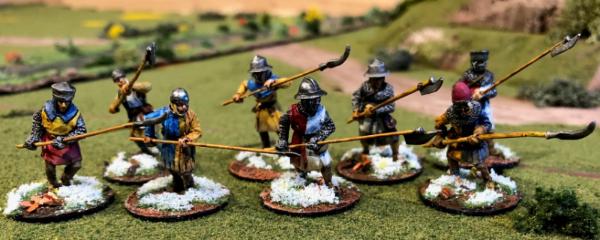
Here I have a unit of archers, drafted from the local converts to Christianity. I’ve chosen a simple, basic scheme that still tries to maintain unit coherency. Inspiration can come in many forms, and these were inspired by another painter’s Slavic levy, which was all in white/off-white kit. The Teutonic order regularly marched into battle with native support and putting these in as archers/woodsmen seemed to fit with a more ideal sense of the heavies being Europeans. All of the minis are from Footsore, out of their Viking range. The look and feel lined up well for a ‘poor’, somewhat lower tech local population.
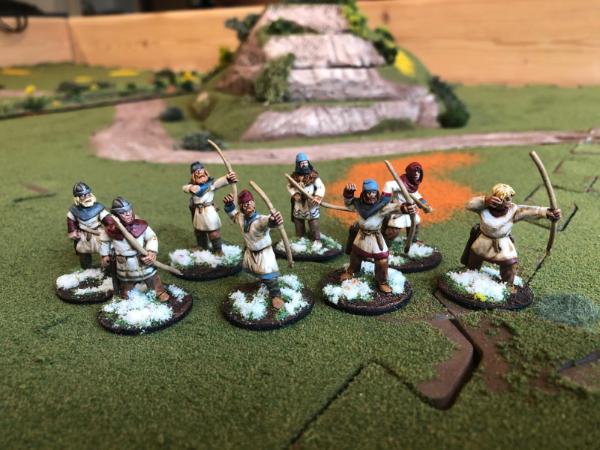
Lastly is a unit of crossbowmen, again done in very simple colors, intended to be members of the Teutonic Order. Crossbows were an extremely popular weapon for the Christian forces, and at various times their sale to the pagans was banned. They gave a tactical advantage in the dense terrain and raiding warfare that was hard to pass up. Good punch and easy to use gives the potential for a tactical battlefield changer.
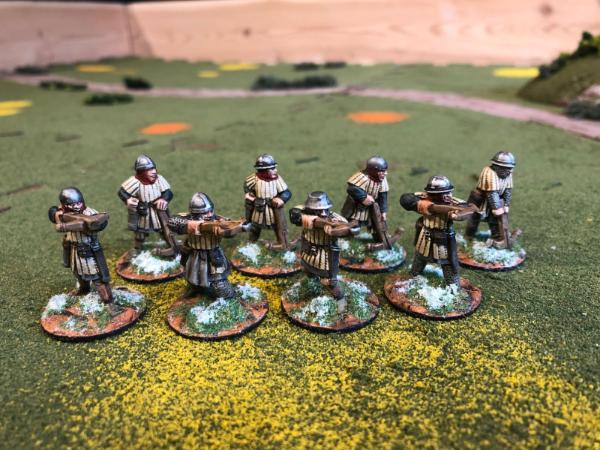
These are all crusader miniatures and look to be a little ‘older’ than the rest of their late crusade range. They do the job very well, but some are a little chunky (much more so than the knights). Less flash and miscasting then Gripping Beast, and they do the job very well. Not a bad pickup at $13 (purchased when the exchange rates were low).
The army has been based so that it can be used for Saga or Fistful of Lead. I still have a unit of Teutonic Knights, a third mounted group of knights, and another body of foot spearmen to add to the mix. That will have to come with time though as work is starting to gear back up. Not bad for a fun, characterful force painted during down time due to the plague.
A closing shot of the entire force so far.
